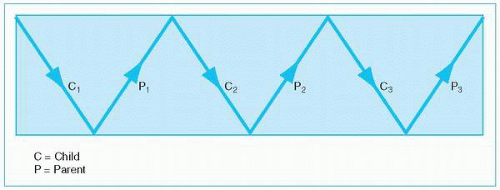First Relationships
Children from birth begin to interpret surrounding environmental stimulation such as parental treatment.
A relationship implies a pattern of interactions between two people over time.
Parental behaviors have their roots in many sources, a phenomenon frequently referred to as “ghosts in the nursery.”
Temperament refers to a child’s behavioral style when interacting with the environment.
Goodness of fit is linked to the demands and expectations of parents and the child’s temperament and abilities.
Parents and their children develop a style of interacting that is the beginning of social development.
TERMS
Difficult children
Easy children
Ghosts in the nursery
Goodness of fit
Reciprocal interactions
Relationship
Slow-to-warm-up children
Temperament
Children from birth seek stimulation from their environment and instantly interpret how they are being treated. This process is called reciprocal interactions (Figure 28-1); that is, infants react to the way they are treated and they change accordingly. As a result of the changes in babies, those persons around the infants (usually the parents) also change.
 This process is called reciprocal interactions (Figure 28-1).
This process is called reciprocal interactions (Figure 28-1).Infants are ready to respond to social stimulation. It is not just a matter of responding passively, however: Infants in their own way initiate social contacts. Many of their actions (such as turning toward the mother or gesturing in her direction) are forms of communication. Those around infants may try to attract their attention, but the babies actively select from these adult actions. In other words, infants begin to structure their own relationships according to their own unique temperaments.
A relationship implies a pattern of interactions between two people over an extended period of time. A child’s relationships incorporate many aspects of development:
Physical aspects, such as walking, running, and playing with a peer
Language aspects, which enable youngsters to share their lives
Cognitive aspects, which allow them to understand one another
Emotional aspects, which permit them to make a commitment to another
Social aspects, which reflect both socialization and individuation
In other words, a relationship is a superb example of the influence of biopsychosocial interactions.
There are many dimensions to a relationship: the role that parents see themselves playing, their behavior, their perceptions, and their feelings for their child. What parents say or do is significant, but how their child perceives and judges that behavior is even more important. Children are excellent judges of how they are being treated.
 Figure 28-1 Reciprocal Interactions
Stay updated, free articles. Join our Telegram channel
Full access? Get Clinical Tree
 Get Clinical Tree app for offline access
Get Clinical Tree app for offline access
Get Clinical Tree app for offline access

|
